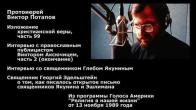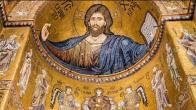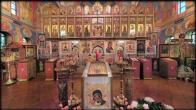You are here
St. John Damascene
4/17 December
The renowned writer and Church poet, Saint John Damascene, served at the court of the caliph in his youth and was the ruler of the city of Damascus. A native of Syria, he lived in the middle of the 8th century, when the iconoclastic heresy was raging in the Byzantine Empire: icons were being destroyed, and their venerators were being severely persecuted. Being a highly education man and a gifted writer, John very convincingly wrote in defense of the Orthodox veneration of icons.
The Greek Emperor Leo the Isaurian, a convinced iconoclast, became enraged at John for his compositions. He ordered his scribe to learn Saint John's handwriting and to write a letter, as if in his name, addressed to the Byzantine Emperor, in which John supposedly offers his services to the Isaurian in overthrowing the caliph. The Isaurian Emperor sent this forged letter off to the caliph as proof of his friendship towards the caliph and the treason of John Damascene.
The eastern despot, without investigating the matter and not accepting John's explanation, ordered that he be confined in prison and that his right hand, which had supposedly written the treasonous letter, be cut off. Having an icon of the Mother of God with him in the prison, Saint John placed his cutoff right hand before it and prayed long before the icon, pouring out his woe. The Immaculate Virgin appeared to the sufferer in his sleep, and gazing mercifully at him said: "Thy hand is now whole; sorrow no more". John awoke and with joyful astonishment saw that the cutoff hand had adhered to its place and become whole, just as before. Only a narrow scar remained that reminded of the punishment. In an excess of joy and gratitude to the merciful Intercessor, John composed in his soul the hymn: "In thee, O Full of Grace, all creation rejoiceth". This hymn is sung in Church till now at the Liturgy of Saint Basil the Great.
News of the miracle reached the caliph, and he, on summoning John, patiently investigated his case and became convinced of his innocence. Realizing that he was guilty before John, the caliph, in order to make amends for his unjustness, offered him a huge recompense and high honors. But John, having come to understand how fragile earthly goods and worldly glory are, refused everything. In gratitude to the Mother of God, he ordered a representation of his hand in silver and fastened it to the icon before which the miracle was performed. This icon received the name, "Of the Three Hands".
Having distributed his possessions, he retired in the attire of the common people to the monastery of Saint Sabbas the Sanctified, which is located twentyfive kilometers southeast of Jerusalem. Since John was a very renown man, none of the monks of the Lavra of Saint Sabbas could bring himself to take him as a novice. Finally, one elder agreed to direct him on the condition that for the sake of humility John would no longer write anything. John agreed and began to live and labor in the monastery as an ordinary monk.
In a few years, the father of a monk who had become friends with John died, and he asked John to write some kind of requiem prayer for him. In a surge of inspiration, Saint John wrote the prayershymns which till now are sung in church at funerals. One of this hymns begins with the words "What sweetness in life does not partake of sadness…" In the versification of the poet,
Alexei Tolstoi, it sounds thus:
What sweetness in this life
Does not partake of earthly sadness?
What expectation is not in vain,
And where amongst men is the happy man?
All is changeful, all is paltry
That with difficulty we have gained
What glory on earth
Stands firm and unchanging?
All is ashes, a phantom, shadow and smoke,
All vanishes like a whirlwind of dust,
And before death we stand
Unarmed and powerless.
The arm of the mighty man is weak,
Null are the commands of kings
Receive thy servant now fallen asleep,
O Lord, into the dwellings of the blessed.
On learning that John had violated the obedience that had been placed upon him and had written a prayer, the elder became angry at him and wanted to expel him from the monastery. Then all the brethren of the monastery began to intercede for John. The elder agreed to forgive the disobedient one on the condition that he clean out all the filthy places in the monastery with his own hands. Saint John humbly fulfilled this severe demand of his elder. After this, the Mother of God appeared to the elder in his sleep and said: "Do not stop up my wellspring any longer. Grant it to flow unto the glory of God". On awakening, the elder understood that it was pleasing to God that John Damascene dedicate himself to the labor of writing.
From that time on, no one hindered John any longer from writing theological compositions and composing liturgical prayers. In the course of several years of uninterrupted labors, he enriched the Church with many compositions, prayers and liturgical canons, which till now adorn the Orthodox divine services. Many hymns of the Paschal, Nativity and other festal divine services belong to his pen. The Octoechos (Book of the Eight Tones), which is used at the Sunday divine services, was compiled by him. Being a penetrating theologian, Saint John wrote the renown book, "An Exact Exposition of the Orthodox Faith", in which he summed up the basic truths of the Christian faith. Saint John Damascene died in the year 777.
Relics in cathedral - monthly calendar
| S | M | T | W | T | F | S |
|---|---|---|---|---|---|---|
|
|
|
|
1
|
2
|
3
|
4
|
|
5
|
6
|
7
|
8
|
9
|
10
|
11
|
|
12
|
13
|
14
|
15
|
16
|
17
|
18
|
|
19
|
20
|
21
|
22
|
23
|
24
|
25
|
|
26
|
27
|
28
|
29
|
30
|
31
|
|
PARISH LIFE
Address of our Cathedral
While all the materials on this site are copyrighted, you may use them freely as long as you treat them
with respect and provide attribution on the Russian Orthodox Cathedral of St.John the Baptist of Washington DC.









